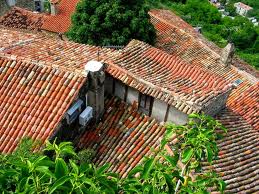
Unique Susak
 Susak is one of the most unique islands on the Adriatic coast. It is located in the North Adriatic Sea in the region called Kvarner. Susak's origin, geology, architecture, tradition, animal, plants, language... it is a story for itself.
Susak is one of the most unique islands on the Adriatic coast. It is located in the North Adriatic Sea in the region called Kvarner. Susak's origin, geology, architecture, tradition, animal, plants, language... it is a story for itself. 
A big pile of fine fertile sand
 |
| Drawings in sand |
 |
| View of the bay from upper village |
Name Susak or how local call it Sansego, comes from the Greek word Sansegus which means oregano, which is abundant throughout the island. There are two villages on the island: Gorenje selo (upper village) located on the hill and Donje selo (lower village).
 |
| Traditional folk-custome during festival |
Susak is Island that is one of the most distant islands from the Croatian mainland and therefore it has retained many original traditions , such as archaic dialect and folk-costumes that are unique only to this little island. Dialect is impossible to understand whether you're Croatian, Italian, Austrian... Traditional folk-costumes are considered the most beautiful among all Croatian folk-costumes - rich in color and intricate details. Young women wear colorful short ballet tutu-shaped skirt, a matching vest and pink or orange woolen stockings. Now-days, traditional costumes are worn only for special festivities by young woman and men who perform traditional Susak dance.
Migration to USA
 The end of communist regime in 1990 marked a turning point in history of this island. People who have emigrated, once again could freely return to their island. However, due to the fact that most of these people still had jobs, families and their whole new lives in the United States, almost none have returned for good. The ones who retired have chosen to spend their last days on the island where they were born.
The end of communist regime in 1990 marked a turning point in history of this island. People who have emigrated, once again could freely return to their island. However, due to the fact that most of these people still had jobs, families and their whole new lives in the United States, almost none have returned for good. The ones who retired have chosen to spend their last days on the island where they were born.Vineyards in sand
Susak has long tradition in growing vine, even from Roman times, so it is considered that Susak wines are one of the best in Croatia. Vineyards are located on the hilltop of the island and it is impressive to see how Susak variety of wine has adapted to sand soil. When you're on Susak make sure you visit Kozulich winery in the upper village and try Sansego or Trojiscina red wine.
Accommodation
 There are many houses on Susak that are available for rent. One of the is apartments Tarabokija or check out local agency. In case you are visiting Susak just for the day, then I recommend staying in seaside apartments in nearby island of Losinj.
There are many houses on Susak that are available for rent. One of the is apartments Tarabokija or check out local agency. In case you are visiting Susak just for the day, then I recommend staying in seaside apartments in nearby island of Losinj.
(text and photos: www.wikipedia.com, www.find-croatia.com, www.tz-malilosinj.hr)
Accommodation
 There are many houses on Susak that are available for rent. One of the is apartments Tarabokija or check out local agency. In case you are visiting Susak just for the day, then I recommend staying in seaside apartments in nearby island of Losinj.
There are many houses on Susak that are available for rent. One of the is apartments Tarabokija or check out local agency. In case you are visiting Susak just for the day, then I recommend staying in seaside apartments in nearby island of Losinj.














































